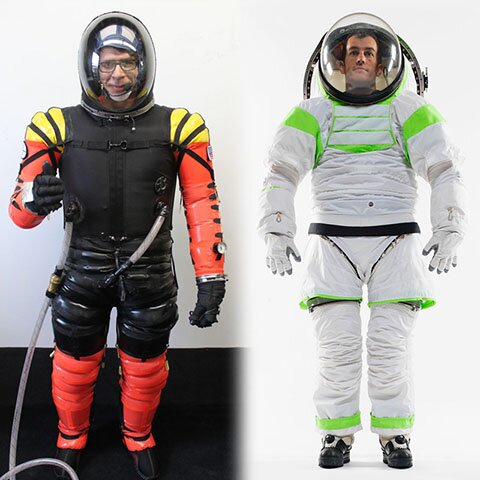
The Tale of Two Spacesuits
January 4th, 2013 I don’t know how many times I’ve said it. Anything the State can do, we can do better. And I don’t just mean common market items like bread and circuses. I’m talking big stuff – schools – hospitals – police – fire protection – currency – environmental protection – roads – EVERYTHING! Everything they do the market can do better, if only they would get out of the way. So, of course spacesuits are no exception.
I don’t know how many times I’ve said it. Anything the State can do, we can do better. And I don’t just mean common market items like bread and circuses. I’m talking big stuff – schools – hospitals – police – fire protection – currency – environmental protection – roads – EVERYTHING! Everything they do the market can do better, if only they would get out of the way. So, of course spacesuits are no exception.
The public sector is where innovation goes to die. NASA has been languishing in obscurity for years since their initial success. And that success was largely the result of initially hiring engineers with habits and work ethics developed in the market. Bureaucracy has since swallowed all of that.
To prove this point let’s take a look at two spacesuits developed recently. The new NASA Z-1 prototype, and the 3G spacesuit developed by the Brooklyn-based start up Final Frontier Design.
FFD is a dynamic entrepreneur duo that’s been developing a lightweight, inexpensive, and highly agile space suit suitable for both suborbital and orbital commercial space travel . Co-inventor Nikolay Moiseev has 20 years of flight suit development experience with European and Russian space agencies, and Co-inventor Ted Southern has 10 years experience in the costume and special effects industry in New York, which is an awesome recipe for charging the stagnant space industry with the vigor and foresight of science fiction.
The two originally teamed up and won the Astronaut Glove Challenge in 2009, and they are now applying that drive to developing entire suits.
Funded by Kickstarter, the FFD Third Generation (3G) suit is designed to conform to the standards of NASA flight certification, and includes a higher operating pressure, a carbon fiber waist ring, a retractable helmet, and the improved disconnecting gloves. They are also collapsible into a very tight space, serving an emergency backup in case of loss of cabin pressure, like the oxygen masks in commercial airliners.
The target retail value of the FFD 3G Suit is just $10,000. Let’s see how NASA’s mutli-million dollar suit compares.
The big new innovation on the new NASA Z-1 prototype is … wait for it … It looks vaguely like Buzz Lightyear. This suit represents the first major overhaul in NASA spacesuits since the EMU shuttle suit in 1998 and the primary improvement is entirely cosmetic. Any other technology company in the world would be bankrupt by now if they waited that long to improve. It also represents a colossal shortsightedness. Buzz Lightyear is pop culture. If they wait another 25 years for their next redesign no one will remember who Buzz Lightyear is. Does anyone remember the space suits in the Lost In Space movie from 1998?
But who am I kidding? 25 years from now NASA will look like an Amish taxi service compared to what the market provides.
What are the other big innovations in the NASA Z-1 Suit? Rear-entry. Amy Ross, one of the engineers responsible for the new suit design said “the shuttle EMU splits at the waist and you put pants on and you put the top on separately and they connect in the middle. Whereas with this suit, the subject crawls in through the back.” That’s right, it took NASA 25 years to figure out that astronauts don’t have to put their pants on one leg at a time. They’re hoping this will lead to less injuries putting the suit on.
They boast that the new suit is more flexible than the old suit, but it weighs an extra 58 pounds, while the FFD 3G suit is both more flexible and lighter weight.
After the moon landing in 1969 many people were certain that society was going to space. But they spent 40 years waiting for the State to make it happen. Well, now that the market has a hold of the project I’m certain it’s right around the corner. I just hope when we go that the State is not invited.
Visit http://www.SilverCircleMovie.com to learn more about our upcoming 3D animated film. Also, the Silver Circle graphic novel is available now at the following hyperlinks in full color and black and white.

